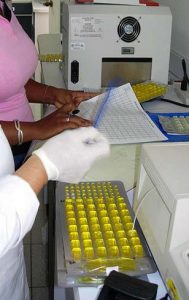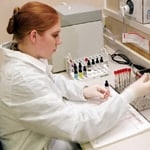
Why Is My Dog or Cat’s Anion Gap Reading High Or Low?
Ron Hines DVM PhD
 See What Normal Blood & Urine Values Are
See What Normal Blood & Urine Values Are
 Causes Of Most Abnormal Blood & Urine Tests
Causes Of Most Abnormal Blood & Urine Tests
Your Pet’s Anion Gap Na+ + [K+] – (Cl- and HCO3−) = Anion Gap
Or simplified: Na+ − (Cl- and HCO3−) = Anion Gap
Your dog or cat’s anion gap value is measured indirectly based on the results of the individual tests given above. The Anion Gap measures the difference between the amount of the major positively charged cations (sodium and potassium) in your cat or dog’s blood minus the amount of negatively charged anions (chloride and bicarbonate).
Your veterinarian calculates the anion gap by subtracting the amount of the most common anions from the amount of the most common cations in your pet’s blood. That number should be a positive number (between about 8 and 33, some say 15-25). In the laboratory report, the number is given in milliequivalents per liter of blood (mEq/L).
This test is an indicator of your pet’s acid:base balance, its blood pH and its bicarbonate buffer blood reserves. It is critical that the acidity (pH) of your dog or cat’s body be kept within a very tight range by the continual presence of carbonate (=bicarbonate=HCO3-) in its blood and your pet’s kidney’s ability to discharge excess chloride into its urine while conserving bicarbonate.
When your pet’s AG number is abnormal, it is usually because it is a higher number than it should be. A high AG value means your dog or cat is suffering from metabolic acidosis – a condition in which the level of acid in its body is increased (i.e. blood pH is too low). That is usually because your pet is deficient in bicarbonate – either because it was consumed (used up) or was lost from its body through its kidneys or the digestive tract. (read here) So the treatment for a high anion gap is generally solutions of intravenous sodium bicarbonate buffer (aka baking soda).
Health Problems That Can Cause Increased Anion Gap (Acidosis) In Your Pet:
The most common cause in mature and elderly dogs and cats is chronic kidney disease. I mentioned that your dog or cat‘s kidneys are the chief organs responsible for keeping its blood pH in a narrow safe range. So, not surprisingly, sudden kidney failure, such as in antifreeze poisoning and other causes of acute kidney injury such as occasionally occurs with leptospirosis infection and other kidney infections can have the same effect can also increase your pet’s anion gap value.
Probably the next most common causes of increased anion gap values are urinary tract blockage, as often occur in FUS in cats, oxalate stone urinary tract blockages (read about them in dogs here & in cats here) or struvite stones blocking the urinary system. Bladder paralysis due to a spinal cord injury (neurogenic bladder) can also be the cause.
The next most common cause is probably poorly managed diabetes. When your pet’s blood sugar levels are not under control, the end result is metabolic acidosis – in this case lactic acidosis and ketoacidosis – as those products build up in your pet’s blood stream. A similar effect occurs in starvation, a cause of ketoacidosis as well.
All the health problems that negatively affect blood flow and oxygenation throughout your pet’s body can elevate your pet’s anion gap. One of them is the circulatory collapse that accompanies septic shock or the sluggish blood flow and lack of blood oxygen that occurs in pets in the late stages of heart failure (hypoxia). Another cause in dogs can be very large heartworm burdens when caval syndrome (=pulmonary artery or its branches plugged with heartworms) exists that obstruct the flow of blood are another cause of hypoxia. (read here) Blood clots that occur in cats and dogs with cardiomyopathy are another possible cause.
All problems that prevent proper oxygen intake (respiratory distress, pneumonia, prolonged surgical anesthesia) can increase your pet’s anion gap. Health problems that cause muscle rigidity or damage muscle fibers can lead to a high anion gap. Those can be related to heat stroke (hyperthermia) seizures or extreme exertion when muscle becomes deficient in oxygen (=muscle hypoxia, lactic acidosis, aka exertional rhabdomyolysis).
Another cause of an increased anion gap is poisoning with ethylene glycol antifreeze. That occurs both because of the effects of that chemical on the pet’s body and the severe damage it does to your pet’s kidneys. Salicylate medications (e.g. aspirin, oil of wintergreen, etc.) can cause an increase in your dog or cat’s anion gap through their effects on their kidneys as can overuse of urinary acidifiers. A deficiency in aldosterone, as occurs in Addison’s disease can also cause a mild increased in your pet’s anion gap.
Dogs with babesia infections occasionally have an increased anion gap. I do not know why.
Conditions That Can Causes A Lower Than Normal Anion Gap:
The most common cause is a low blood albumin level. Quite rarely, a tumor of the pet’s immune cells (e.g. multiple myeloma) in which large amounts of globulin protein are released into your pet’s blood stream can have the same effect.
Complementary Tests:
CBC / WBC and Blood Chemistry Panel, blood carbonate/CO2 level, blood pH
DxMe
You are on the Vetspace animal health website
Visiting the products that you see displayed on this website help pay the cost of keeping these articles on the Internet.

